
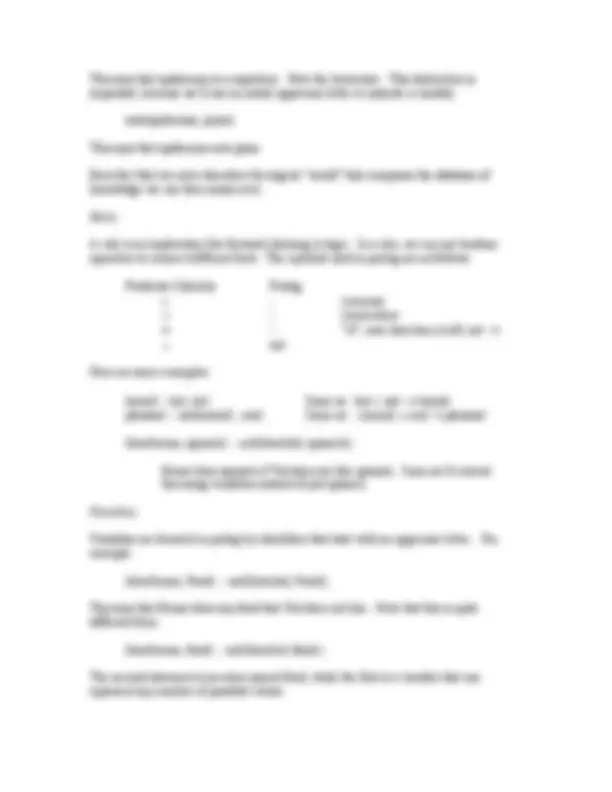
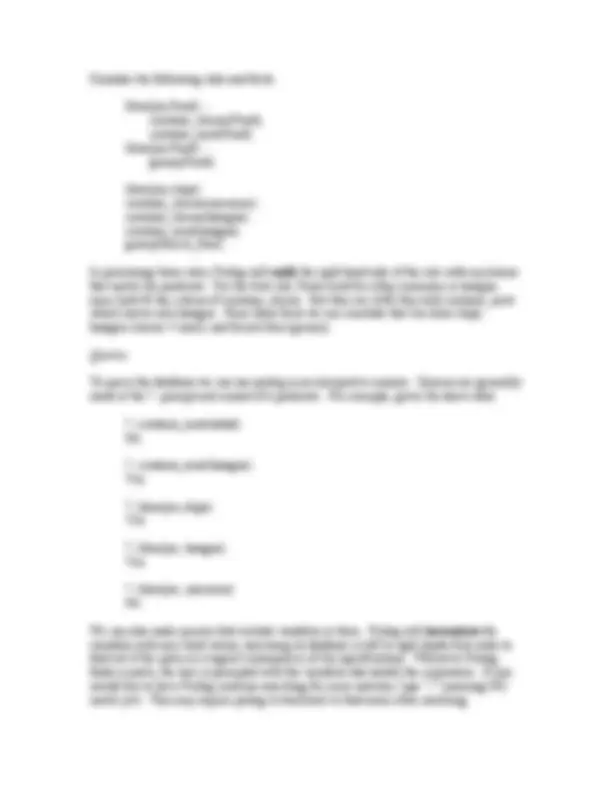
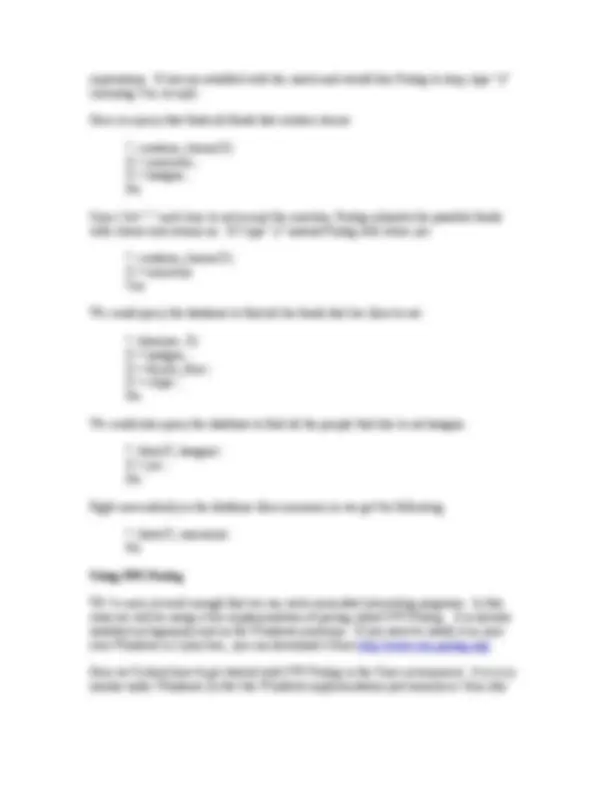
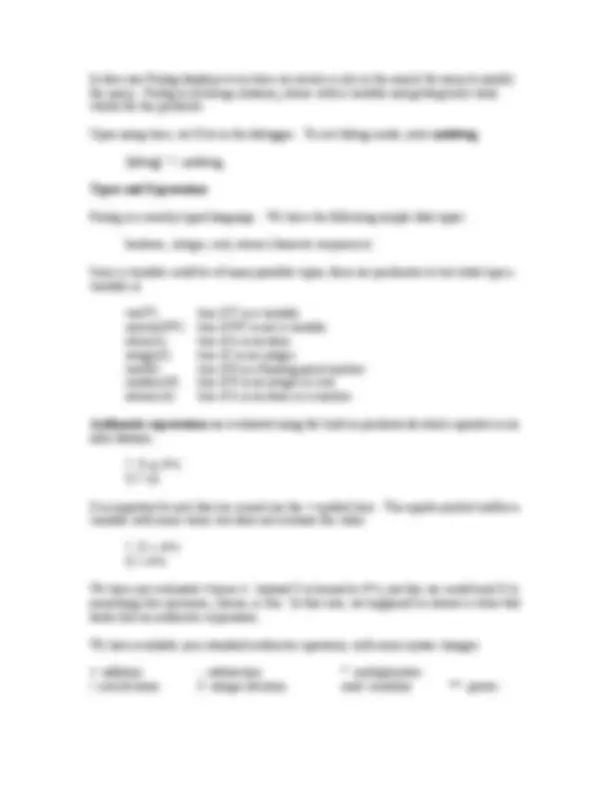
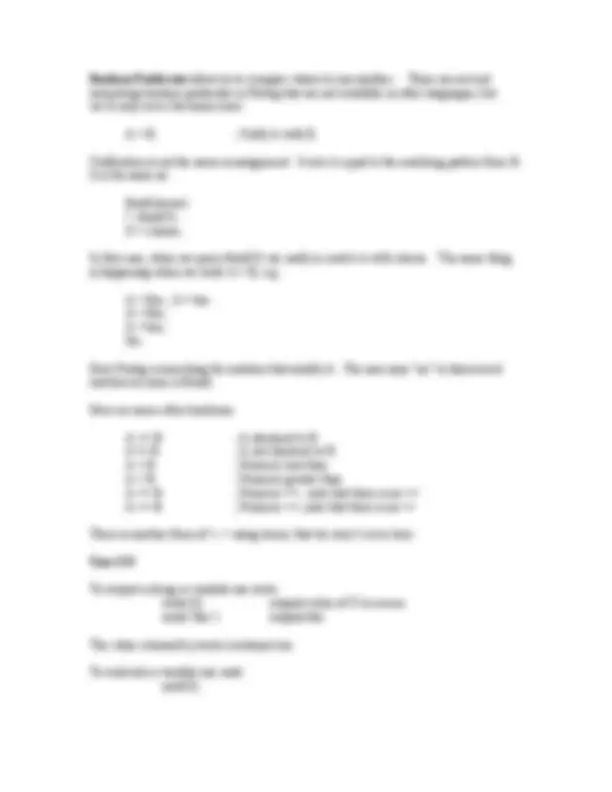
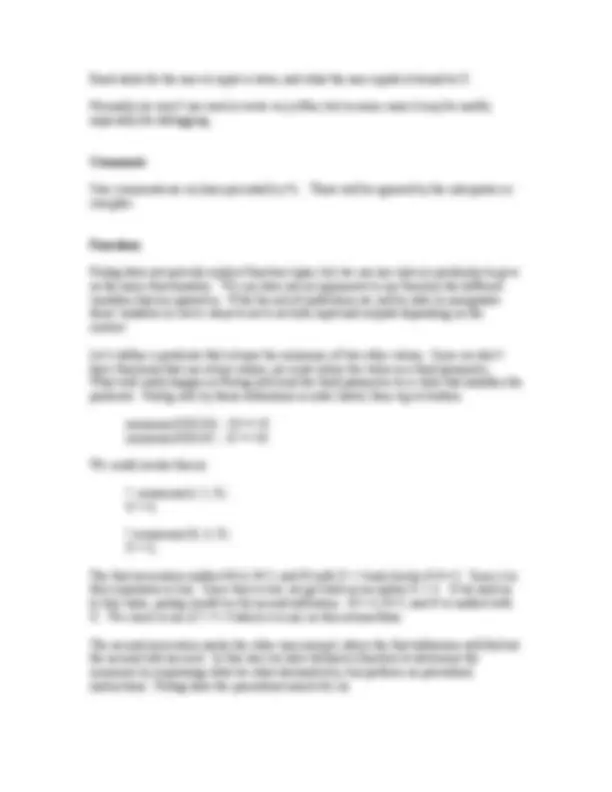
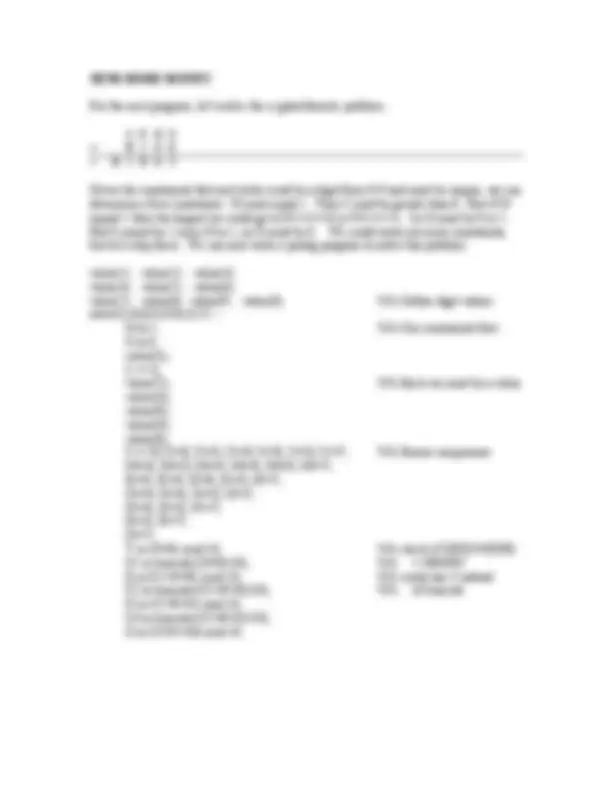
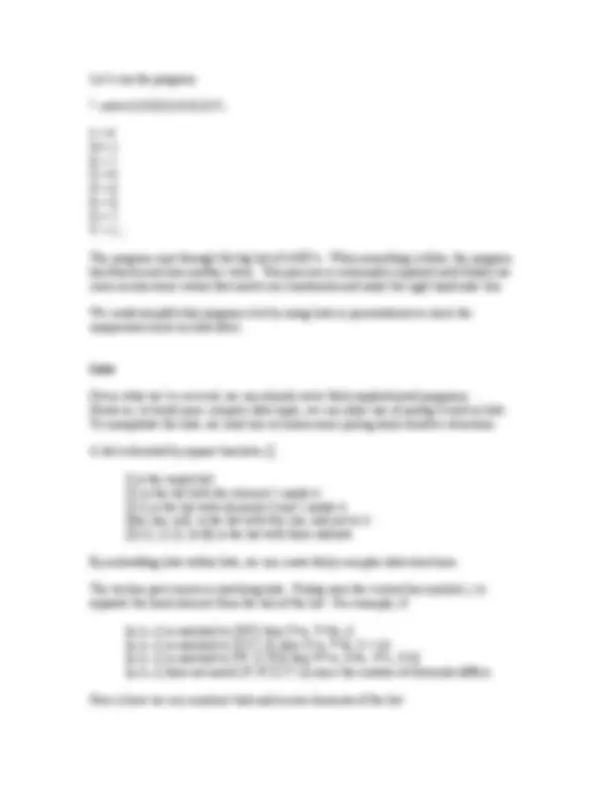
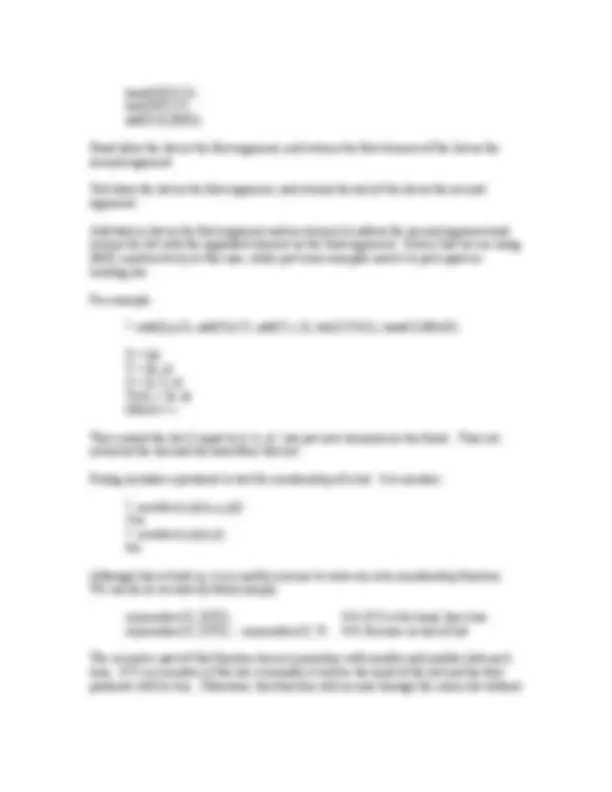
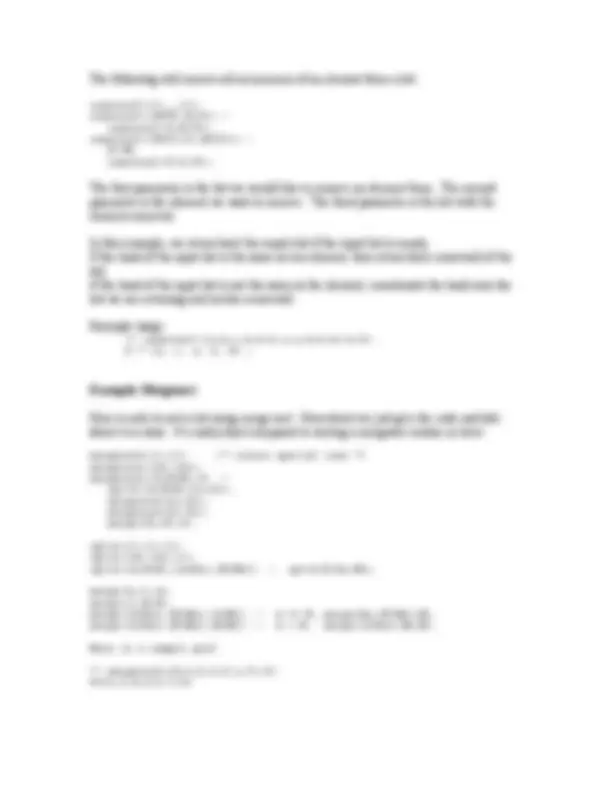
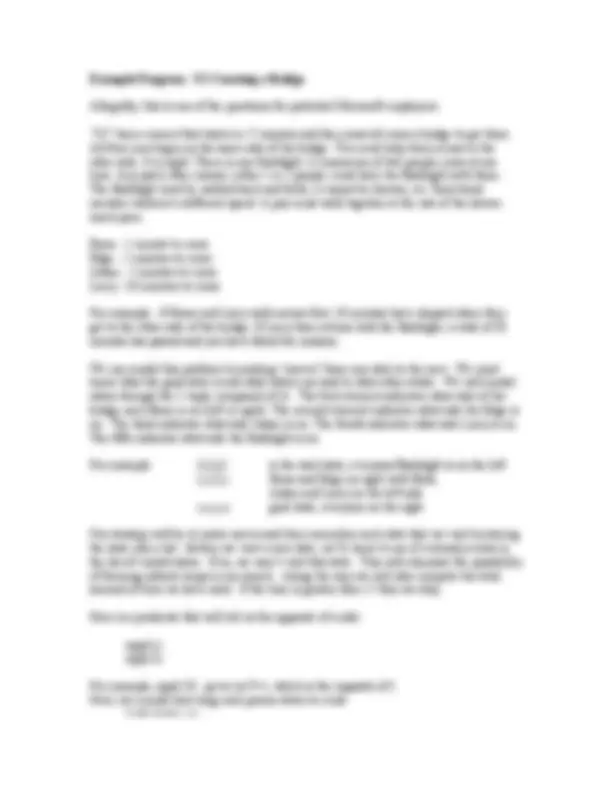
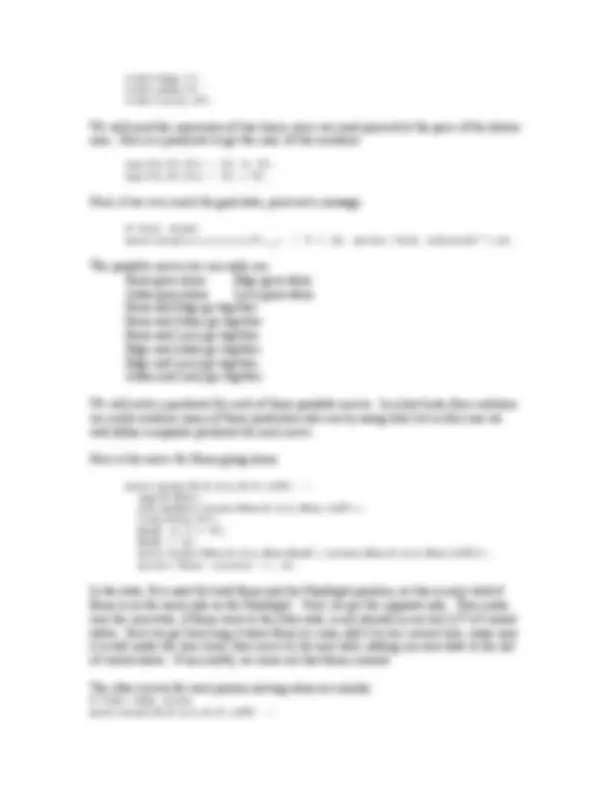
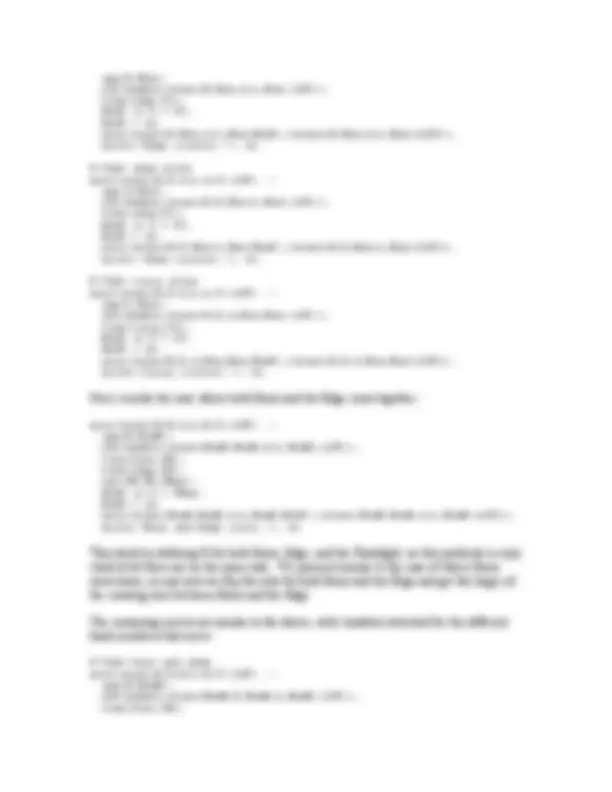
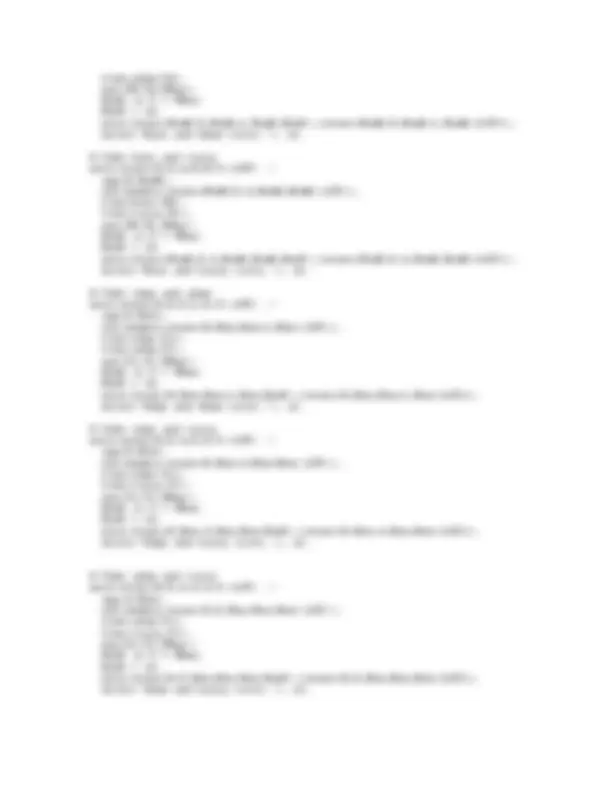
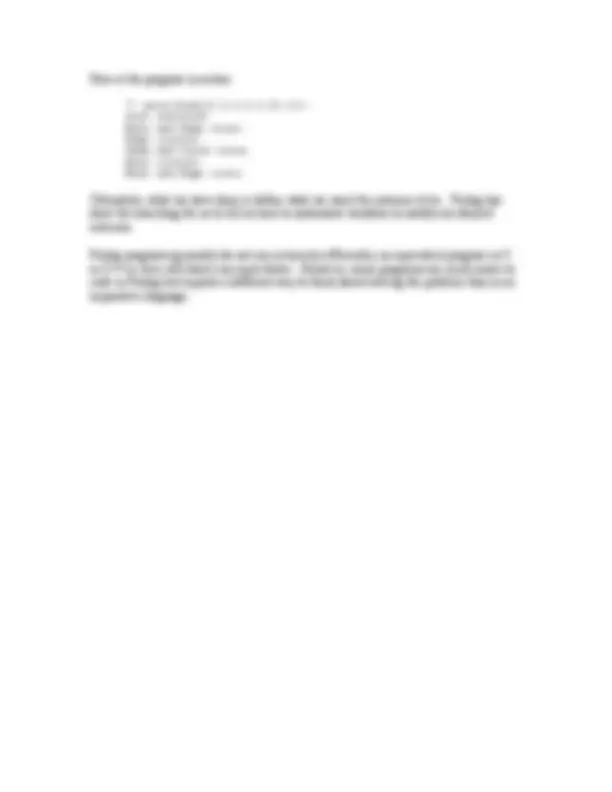


Study with the several resources on Docsity

Earn points by helping other students or get them with a premium plan


Prepare for your exams
Study with the several resources on Docsity

Earn points to download
Earn points by helping other students or get them with a premium plan
Community
Ask the community for help and clear up your study doubts
Discover the best universities in your country according to Docsity users
Free resources
Download our free guides on studying techniques, anxiety management strategies, and thesis advice from Docsity tutors
Material Type: Notes; Professor: Mock; Class: Programming Concepts I; Subject: Computer Science ; University: University of Alaska - Anchorage; Term: Unknown 1989;
Typology: Study notes
1 / 23

This page cannot be seen from the preview
Don't miss anything!
















Intro to Prolog Chapter 11
Prolog, which stands for PROgramming in LOGic, is the most widely available language in the logic programming paradigm using the mathematical notions of relations and logical inference. Prolog is a declarative language rather than procedural, meaning that rather than describing how to compute a solution, a program consists of a data base of facts and logical relationships (rules) that describes the relationships which hold for the given application. Rather then running a program to obtain a solution, the user asks a question. When asked a question, the run time system searches through the data base of facts and rules to determine (by logical deduction) the answer.
Often there will be more than one way to deduce the answer or there will be more than one solution, in such cases the run time system may be asked to backtrack and find other solutions. Prolog is a weakly typed language with dynamic type checking and static scope rules.
Prolog is typically used in artificial intelligence applications such as natural language interfaces, automated reasoning systems and expert systems. Expert systems usually consist of a data base of facts and rules and an inference engine, the run time system of Prolog provides much of the services of an inference engine.
Basic Propositional Logic
Propositional logic provides the foundation for programming in Prolog. A proposition is formed using the following rules:
Book uses ⊃ in place of ⇒ for implication, where p ⇒ r is equivalent to ¬p ∨ r. For example, a proposition might be p ∨ q ∧ ¬r which ultimately evaluates to true or false.
Predicate logic expressions include all propositions and also include variables in the domain. A predicate is a proposition in which some of the Boolean variables are replaced by:
Here are some examples of Boolean-valued functions:
prime(n) - true if n is prime 0 < x - true if 0 < x president-of-usa(x) - true if x is the president of the USA
A predicate combines these kinds of functions using operators of the propositional calculus and the universal quantifier, ∀ (which reads “for all”), and the existential quantifier, ∃ (which reads “there exists”).
For example:
∀x (speaks(x,Russian)) - true if everyone on the planet speaks Russian, false otherwise Note that this is not true for ONLY Russian speakers, this applies to everyone
∃x (speaks(x,Russian)) - true if at least one person on the planet speaks Russian
∀x∃y (speaks(x,y)) – true if for all people x, there exists a language y such that x speaks y; false otherwise
∀x (¬literate(x) ⇒ (¬writes(x) ∧ ¬∃y(reads(x,y) ∧ book(y)))) - true if every illiterate person x does not write and does not read a book y
A tautology is a proposition that is true for all possible values of their variables. A simple example is: q ∨ ¬q. If q is true the entire expression is true. If q is false the expression is still true.
Predicates that are true for some assignment of values to their variables are called satisfiable. Those that are true for all possible assignments of values to their variables are called valid.
A prolog program is essentially an implementation of predicate logic.
Prolog Syntax
Prolog is based on facts, rules, queries, constants, and variables. Facts and rules make up the database while queries drive the search process. Facts, rules, and queries are made up of constants and variables. All prolog statements end in a period.
Facts
A fact is a proposition and begin with a lowercase alphabetic character and ends in a period. Here are some sample facts:
sunny.
This says that sunny is true.
superhero(spiderman).
Consider the following rules and facts:
likes(joe,Food) :- contains_cheese(Food), contains_meat(Food). likes(joe,Food) :- greasy(Food).
likes(joe,chips). contains_cheese(macaroni). contains_cheese(lasagna). contains_meat(lasagna). greasy(french_fries).
In processing these rules, Prolog will unify the right hand side of the rule with any atoms that match the predicate. For the first rule, Food could be either macaroni or lasagna since both fit the criteria of contains_cheese. But then we AND this with contains_meat which leaves only lasagna. From these facts we can conclude that Joe likes chips, lasagna (cheese + meat), and french fries (greasy).
Queries
To query the database we can use prolog in an interpretive manner. Queries are generally made at the ?- prompt and consist of a predicate. For example, given the above data:
?- contains_meat(salad). No
?- contains_meat(lasagna). Yes
?- likes(joe,chips). Yes
?- likes(joe, lasagna) Yes
?- likes(joe, macaroni) No
We can also make queries that include variables in them. Prolog will instantiate the variables with any valid values, searching its database in left to right depth-first order to find out if the query is a logical consequence of the specifications. Whenever Prolog finds a match, the user is prompted with the variables that satisfy the expression. If you would like to have Prolog continue searching for more matches, type “;” (meaning NO match yet). This may require prolog to backtrack to find some other matching
expressions. If you are satisfied with the match and would like Prolog to stop, type “y” (meaning Yes, accept).
Here is a query that finds all foods that contain cheese:
?- contains_cheese(X). X = macaroni ; X = lasagna ; No
Since I hit “;” each time to not accept the matches, Prolog exhausts the possible foods with cheese and returns no. If I type “y” instead Prolog will return yes:
?- contains_cheese(X). X = macaroni Yes
We could query the database to find all the foods that Joe likes to eat:
?- likes(joe, X). X = lasagna ; X = french_fries ; X = chips ; No
We could also query the database to find all the people that like to eat lasagna:
?- likes(X, lasagna). X = joe ; No.
Right now nobody in the database likes macaroni so we get the following:
?- likes(X, macaroni). No
Using SWI Prolog
We’ve now covered enough that we can write somewhat interesting programs. In this class we will be using a free implementation of prolog called SWI Prolog. It is already installed on bigmazzy and on the Windows machines. If you want to install it on your own Windows or Linux box, you can download it from http://www.swi-prolog.org/
Here we’ll show how to get started with SWI Prolog in the Unix environment. It is very similar under Windows (in fact the Windows implementation just launches a Unix-like
To exit the prolog interpreter, hit control-d again.
% halt
It is often inconvenient to have to enter our data every time we start prolog and go back and forth between user mode and query mode. We can direct prolog to load its facts from a file instead of from the keyboard. To do so, but all of the prolog code you want into a file in the working directory. SWI Prolog recognizes extensions of “.pl” as being prolog code. To load the file in prolog type either:
consult(filename). or [filename].
This will be the most common way you will input your data to prolog.
For example:
?- [myfile]. % myfile compiled 0.00 sec, 1563 bytes. Yes
One command you may find useful is “trace” especially when we start working with recursive rules. To trace calls, use: trace(predicate).
For example, to trace “likes” and “contains_cheese” we could issue the following:
?- trace(likes). % likes/2: [call, redo, exit, fail]
Yes [debug] ?- trace(contains_cheese). % contains_cheese/1: [call, redo, exit, fail]
Yes [debug] ?- likes(joe,X). T Call: (6) likes(joe, _G342) T Call: (7) contains_cheese(_G342) T Exit: (7) contains_cheese(macaroni) T Redo: (7) contains_cheese(_G342) T Exit: (7) contains_cheese(lasagna) T Exit: (6) likes(joe, lasagna)
X = lasagna
In this case Prolog displays every time we invoke a rule in the search for ways to satisfy the query. Prolog is invoking contains_cheese with a variable and getting back valid values for the predicate.
Upon using trace, we’ll be in the debugger. To exit debug mode, enter nodebug.
[debug] ?- nodebug.
Types and Expressions
Prolog is a weakly typed language. We have the following simple data types:
boolean , integer, real, atoms (character sequences)
Since a variable could be of many possible types, there are predicates to test what type a variable is:
var(V) true if V is a variable nonvar(NV) true if NV is not a variable atom(A) true if A is an atom integer(I) true if I is an integer real(R) true if R is a floating point number number(N) true if N is an integer or real atomic(A) true if A is an atom or a number
Arithmetic expressions are evaluated using the built-in predicate is which operates in an infix fashion:
?- X is 4*4. X = 16
It is important to note that we cannot use the = symbol here. The equals symbol unifies a variable with some value, but does not evaluate the value:
?- X = 44. X = 4
We have not evaluated 4 times 4. Instead X is bound to 4*4, just like we could bind X to something like macaroni, cheese, or foo. In this case, we happened to choose a value that looks like an arithmetic expression.
We have available your standard arithmetic operators, with some syntax changes:
Read waits for the user to input a value, and what the user inputs is bound to X.
Normally we won’t use read or write very often, but in some cases it may be useful, especially for debugging.
Comments
User comments are on lines preceded by %. These will be ignored by the interpreter or compiler.
Functions
Prolog does not provide explicit function types, but we can use rules or predicates to give us the same functionality. We can then use as arguments to our function the different variables that are passed in. With the aid of unification we will be able to manipulate these variables in clever ways to serve as both input and outputs depending on the context.
Let’s define a predicate that returns the minimum of two other values. Since we don’t have functions that can return values, we must return the value in a third parameter. What will really happen is Prolog will bind the third parameter to a value that satisfies the predicate. Prolog will try these definitions in order listed, from top to bottom.
minimum(M,N,M) :- M =< N. minimum(M,N,N) :- N =< M.
We could invoke this as:
?- minimum(4, 5, X). X = 4;
?-minimum(10, 3, X). X = 3;
The first invocation unifies M=4, N=5, and M with X = 4 and checks if 4<=5. Since it is this expression is true. Since this is true, we get back as an option X = 4. If we said no to this value, prolog would try the second definition. M = 4, N=5, and N is unified with X. We check to see if 5 <= 4 which it is not, so this returns false.
The second invocation works the other way around, where the first definition will fail but the second will succeed. In this way we have defined a function to determine the minimum by expressing what we want declaratively, but perform no procedural instructions. Prolog does the procedural search for us.
Example Programs
Now that we have mastered functions, let’s try some sample programs.
Factorial
For the first one, lets try defining factorial. We must do this recursively, starting with a base case and moving on up, where n! equals n*(n-1)! given the base case of 0! equals 1.
factorial(0,1). %% Defines that 0! equals 1 factorial(A,B) :- %% Compute A! return value via B A > 0, C is A-1, %% Note “is” for arithmetic expression factorial(C,D), %% Compute A-1 factorial, get value in D B is AD. %% Our return variable gets set to AD
We can now use this to compute the factorial:
?- factorial(4, X). X = 24
A trace may be helpful to understand what is happening:
?- trace(factorial). [debug] ?- factorial(3,X). T Call: (6) factorial(3, _G354) T Call: (7) factorial(2, _G434) T Call: (8) factorial(1, _G437) T Call: (9) factorial(0, _G440) T Exit: (9) factorial(0, 1) T Exit: (8) factorial(1, 1) T Exit: (7) factorial(2, 2) T Exit: (6) factorial(3, 6)
Here we make the recursive calls until we get to the base case of factorial(0,1). Then the values propagate back up as the recursive calls exit. Note that we can’t run this in reverse because we haven’t specified enough information about A (e.g. we try to subtract 1 from it, but we need a starting value for A):
?- factorial(X,24). ERROR: Arguments are not sufficiently instantiated ^ Exception: (7) _G233>0? Unknown option (h for help) ^ Exception: (7) _G233>0? nodebug
For the next program, let’s solve the cryptarithmetic problem:
S E N D
Given the constraints that each letter must be a digit from 0-9 and must be unique, we can determine a few constraints. M must equal 1. Then S must be greater than 8. But if M equals 1 then the largest we could get is 8+1+1=10 or 9+1+1=11. So O must be 0 or 1. But 0 cannot be 1 since M is 1, so O must be 0. We could work out more constraints, but let’s stop there. We can now write a prolog program to solve this problem:
value(1). value(2). value(3). value(4). value(5). value(6). value(7). value(8). value(9). value(0). %% Define digit values solve(S,M,E,O,N,R,D,Y) :- M is 1, %% Our constraints first O is 0, value(S), S >= 8, value(Y), %% Each var must be a value value(D), value(R), value(N), value(E), S = M, S=E, S=O, S=N, S=R, S=D, S=Y, %% Ensure uniqueness M=E, M=O, M=N, M=R, M=D, M=Y, E=O, E=N, E=R, E=D, E=Y, O=N, O=R, O=D, O=Y, N=R, N=D, N=Y, R=D, R=Y, D=Y, Y is (D+E) mod 10, %% check if SEND+MORE C1 is truncate((D+E)/10), %% = MONEY E is (C1+N+R) mod 10, %% could use // instead C2 is truncate((C1+N+R)/10), %% of truncate N is (C2+E+O) mod 10, C3 is truncate((C2+E+O)/10), O is (C3+S+M) mod 10.
Let’s run the program:
?- solve(S,M,E,O,N,R,D,Y).
S = 9 M = 1 E = 5 O = 0 N = 6 R = 8 D = 7 Y = 2 ;
The program runs through the big list of AND’s. When something is false, the program backtracks and tries another value. This process is continually repeated until finally we come across some values that match our constraints and make the right hand side true.
We could simplify this program a bit by using lists or permutations to check for uniqueness (more on lists later).
Lists
Given what we’ve covered, we can already write fairly sophisticated programs. However, to build more complex data types, we can make use of prolog’s built in lists. To manipulate the lists, we must use recursion since prolog lacks iterative structures.
A list is denoted by square brackets, [].
[] is the empty list. [1] is the list with the element 1 inside it. [3,1] is the list with elements 3 and 1 inside it. [foo, bar, zot] is the list with foo, bar, and zot in it. [[3,1], [2,2], [4,4]] is the list with three sublists
By embedding lists within lists, we can create fairly complex data structures.
The trickier part comes in matching lists. Prolog uses the vertical bar symbol, |, to separate the head element from the tail of the list. For example, if:
[a, b, c] is matched to [X|Y] then X=a, Y=[b, c] [a, b, c] is matched to [X,Y | Z] then X=a, Y=b, Z = [c] [a, b, c] is matched to [W, X,Y|Z] then W=a, X=b, Y=c, Z=[] [a, b, c] does not match [V,W,X,Y | Z] since the number of elements differs.
Here is how we can construct lists and access elements of the list:
finding the element and give back false. We had to list mymember(X, [X|T]) first to terminate recursion since this will be checked before the second definition.
Also notice that in the recursive definition, we declared a variable Y to refer to anything that is in the head position of the list. However, we didn’t use the variable anywhere on the right side of the rule. We just wanted some variable there that is not equal to X. In cases like this, we can instead use something called the anonymous variable. It is denoted by an underscore and serves as a placeholder for a variable whose value we really don’t care about. We can rewrite this as:
mymember(X, [_|T]) :- mymember(X, T).
The functionality will be identical to before. This is a good programming practice where applicable, since it tells the programmer and interpreter that certain variables are used solely for pattern-matching purposes, but not for variable binding.
Prolog contains a number of other useful built-in predicates that deal with lists. Here are some of them:
length(L,X) - X is set to the length of L e.g. length([a,b,c],X). X=3;
reverse(L,R) - R is set to the reverse of L e.g. reverse([a,b,c],R). R = [c,b,a]
union(L1,L2,U) - U is the union of L1 and L e.g. union([1,2,3],[2,4],U). U = [1,2,3,4]
intersection(L1,L2,I) - I is the intersection of L1 and L e.g. intersection([1,2,3],[2,4],I). I = [2]
List Examples
Here are a few more short examples of working with lists.
The following will increment each element in the list by one, and return a new list of incremented values:
inc(X,Y):- Y is X+1. incAll([],[]). incAll([H|T],[R|RT]):- inc(H,R),incAll(T,RT).
The “inc” predicate returns X+1 through Y. The “incAll” predicate takes an input list and the second parameter is the output list of values incremented by one. To terminate the recursion, we define the empty list incremented is just the empty list.
In the more general case, “incAll” is split up in terms of a head and tail for the input and output. We define the lead element of the output list to be the head of the input, incremented by one. We follow this up by defining that the tail must also conform to incAll.
Example usage:
?- incAll([1,4,6],X). X = [2, 5, 7] ;
The following will remove duplicate elements from a list:
removedups([],[]). removedups([X|Rest], Result) :- member(X,Rest), removedups(Rest,Result). removedups([X|Rest], [X|Rest1]) :- not(member(X,Rest)), removedups(Rest,Rest1).
RemoveDups takes as the first argument the list to remove duplicates. The list without duplicates is returned in the second argument.
If the list is empty, the list without duplicates is also empty.
If the head of the list is a member of the rest of the list, it is a duplicate. We don’t include X in the result by invoking removedups with Rest.
If the head of the list is not a member of the rest of the list, it is not a duplicate. Make sure this element is included in the list by concatenating it on front of the outgoing parameter, [X|Rest1].
Example usage:
?- removedups([1,1,2,2,5,6,7,5,9],X). X = [1, 2, 6, 7, 5, 9] ;
Example Program: U2 Crossing a Bridge
Allegedly, this is one of the questions for potential Microsoft employees.
"U2" has a concert that starts in 17 minutes and they must all cross a bridge to get there. All four men begin on the same side of the bridge. You must help them across to the other side. It is night. There is one flashlight. A maximum of two people cross at one time. Any party who crosses, either 1 or 2 people, must have the flashlight with them. The flashlight must be walked back and forth, it cannot be thrown, etc. Each band member walks at a different speed. A pair must walk together at the rate of the slower man's pace.
Bono - 1 minute to cross Edge - 2 minutes to cross Adam - 5 minutes to cross Larry - 10 minutes to cross
For example - If Bono and Larry walk across first, 10 minutes have elapsed when they get to the other side of the bridge. If Larry then returns with the flashlight, a total of 20 minutes has passed and you have failed the mission.
We can model this problem by making “moves” from one state to the next. We must know what the goal state is and what states can lead to what other states. We will model states through the 5-tuple composed of l/r. The first element indicates what side of the bridge each Bono is on (left or right). The second element indicates what side the Edge is on. The third indicates what side Adam is on. The fourth indicates what side Larry is on. The fifth indicates what side the flashlight is on.
For example: l,l,l,l,l is the start state, everyone/flashlight is on the left r,r,l,l,r Bono and Edge on right with flash, Adam and Larry on the left side r,r,r,r,r goal state, everyone on the right
Our strategy will be to make moves and then remember each state that we visit by storing the state into a list. Before we visit a new state, we’ll check to see if it already exists in the list of visited states. If so, we won’t visit that state. This will eliminate the possibility of forming infinite loops in our search. Along the way we will also compute the total amount of time we have used. If the time is greater than 17 then we stop.
Here is a predicate that will tell us the opposite of a side:
opp(l,r). opp(r,l).
For example, opp(l,X). gives us X=r, which is the opposite of l. Next, we encode how long each person takes to cross: time(bono,1).
time(edge,2). time(adam,5). time(larry,10).
We will need the maximum of two times, since we must proceed at the pace of the slower man. Here is a predicate to get the max of two numbers:
max(T1,T2,T2):- T1 =< T2. max(T1,T2,T1):- T1 > T2.
Next, if we ever reach the goal state, print out a message:
% Goal state move(state(r,r,r,r,r,T),_) :- T < 18, write(‘Goal achieved!’),nl.
The possible moves we can make are: Bono goes alone Edge goes alone Adam goes alone Larry goes alone Bono and Edge go together Bono and Adam go together Bono and Larry go together Edge and Adam go together Edge and Larry go together Adam and Larry go together
We will write a predicate for each of these possible moves. In a less brute-force solution we could combine many of these predicates into one by using lists, but in this case we will define a separate predicate for each move.
Here is the move for Bono going alone:
move(state(B,E,A,L,B,T),LST) :- opp(B,New), not(member(state(New,E,A,L,New),LST)), time(bono,T2), NewT is T + T2, NewT < 18, move(state(New,E,A,L,New,NewT),[state(New,E,A,L,New)|LST]), write('Bono crosses.'), nl.
In the state, B is used for both Bono and the Flashlight position, so this is only valid if Bono is on the same side as the Flashlight. First, we get the opposite side. Then make sure the new state, if Bono went to the other side, is not already in our list LST of visited states. Next we get how long it takes Bono to cross, add it to our current time, make sure it is still under the time limit, then move to the new state, adding our new state to the list of visited states. If successful, we write out that Bono crossed.
The other moves for each person moving alone are similar: % Take edge alone move(state(B,E,A,L,E,T),LST) :-